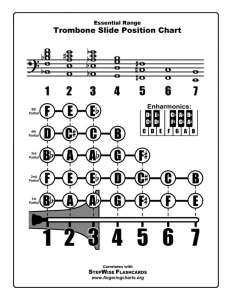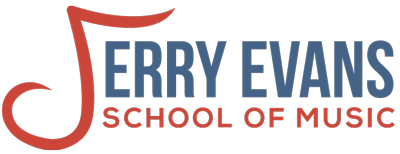Hello all! Once again, I am Zachary Belles, and I am the Brass Instructor here at the Jerry Evans School of Music. Today we will be talking about different aspects of the trombone and why knowing them matters to you. Last time we visited embouchure and went over it very thoroughly, and today we will once again touch on it briefly. When working with my students, I have noticed that not many students are taught the idea of partials on the trombone. I want to focus primarily on partials and slide positions, including why there are actually more than seven slide positions.
So, first things first is embouchure. As we discussed last time, there is a right and wrong way to set your embouchure on your instrument. Your embouchure dictates both your tone and your range, so if you have developed bad embouchure habits, these will suffer. If you feel like you have any of these issues, I recommend that you read my previous article, linked above. This all comes from your mouth and mouthpiece, making that “m” shape with your mouth. Setting your lips in the direct center of the mouthpiece will help you get better tone out of your Trombone.
 The next thing is one of the most important aspects of trombone, and all brass instruments for that matter. I’m of course talking about the partials of the brass instruments. Partials are made up of a series of notes in the harmonic series. Without getting too overly complicated, all you need to know is that the harmonic series is defined by how often sound waves pass a medium (or the line through the waves in the picture to the right) in a second. The more often the sound wave passes through a medium the higher the sound! If the bottom number increases by one each time (½ ⅓ ¼ ⅕ etc) it creates a different note.
The next thing is one of the most important aspects of trombone, and all brass instruments for that matter. I’m of course talking about the partials of the brass instruments. Partials are made up of a series of notes in the harmonic series. Without getting too overly complicated, all you need to know is that the harmonic series is defined by how often sound waves pass a medium (or the line through the waves in the picture to the right) in a second. The more often the sound wave passes through a medium the higher the sound! If the bottom number increases by one each time (½ ⅓ ¼ ⅕ etc) it creates a different note.
After you’ve completed doing this through all conceivable numbers, you get the harmonic series. With each slide position in the trombone, you can play up to 7 different notes in the harmonic series. For example: in 1st position you are able to play in order from lowest to highest: Bb1, Bb2, F3, Bb3, D4, F4, and Bb4 (the numbers dictate the octave). You can notate  each of these as different partials or “harmonic intervals” with Bb1 being the first partial and Bb4 being the 7th partial. You can see the different notes for each partial in each position in the image above. When you get to the higher partials like 6 and 7, or even 8 and 9, playing requires more air and a firmer embouchure to get the instrument to sound. The picture to the left shows all of the possible notes in each slide position based on the harmonic series.
each of these as different partials or “harmonic intervals” with Bb1 being the first partial and Bb4 being the 7th partial. You can see the different notes for each partial in each position in the image above. When you get to the higher partials like 6 and 7, or even 8 and 9, playing requires more air and a firmer embouchure to get the instrument to sound. The picture to the left shows all of the possible notes in each slide position based on the harmonic series.
As you may know, there are seven main positions when dealing with a trombone. However there are actually many, many more than just seven when it comes down to the nitty-gritty. There are a lot of minute changes that need to be made when in specific partials. For example: if you are going to play a high Eb in 3rd position it isn’t going it be in a “true 3rd” because the 6th partial is naturally sharp so you will have to bring the Eb out ever so slightly so it can be in tune. The same goes for if you are going to play a D above the staff in its alternate 4th position. This partial is naturally sharp, so you need to bring it out just a hair in order to play in tune. Students start to discover this when learning a high G above the staff. This is because the 7th partial is VERY flat so when playing a G, instead of playing it in 2nd position, it’s more of a 1.5.
Hope you guys enjoyed this blog post, next time we will be talking about the similarities between Trombone, Euphonium, and Tuba and how to be able to play all three.
Trumpet, French Horn, Trombone, Euphonium, & Tuba Lessons with Zachary Belles
We are blessed to have Zachary as an instructor at the JESM. We invite students from Wheaton, Carol Stream, Glen Ellyn, Lombard, Lisle, West Chicago, Naperville and the other suburbs of DuPage to contact us for their first lesson. Call us today at 630-359-7725 or email us at admin@jeschoolofmusic.com to schedule your first lesson.
















